Show messages:
1-20
21-40
41-60
61-80
81-99
From: VG (VEGASGUITARS)
Just designed this new body in MoI - looking for pointers on how to cut arm and tummy contours. Tried some Boolean commands and trim but could use some experienced advice. Thanks. Attached is the new design photo. Thanks very much for suggestions.
From: Barry-H
Hi Neil,
had a quick try based on Helix Guitars method
https://www.youtube.com/watch?v=Y6hzdp8fUJ4
Barry
From: VG (VEGASGUITARS)
Thanks Barry - clever as usual. Could you possible help to make a contour like the ones in the photos below?
From: Barry-H
Hi Neil,
Is it the curved cutaway and the filleted perimeter?
Have you any 2D profiles and thickness that you want to create ?
If so send them to me else I will work from the photos.
Barry
From: ed (EDDYF)
This is more of a proof of concept. I'm not even sure I made the cut-out on the correct side of the guitar body (it's late & I'm tired :)
Networks and Blends are very useful. But for cutting pieces out of solids, I like to create a solid cutting object and use it to Boolean Diff from the main object.
Fillet takes care of the blending (at least close enough where some sanding will get the blending exactly as you want it.
Draw a solid sphere (orange object)
Squish it down by dragging its boundary box handle.
Tilt and position over the guitar body.
Boolean Diff to cut away.
Select the entire guitar body.
Fillet 0.5" using Shape: Const Dist
I probably dished it out more than desired. Just alter the size, flatness, position & tilt of the orange object as needed to get your desired results. Then save it to re-use in future designs. My Keyshot render in metal flake red is shown below.
The other cut on the front face of the guitar body looks like it would be just a simple Boolean Diff using a profile curve as the cutting object.
Ed Ferguson
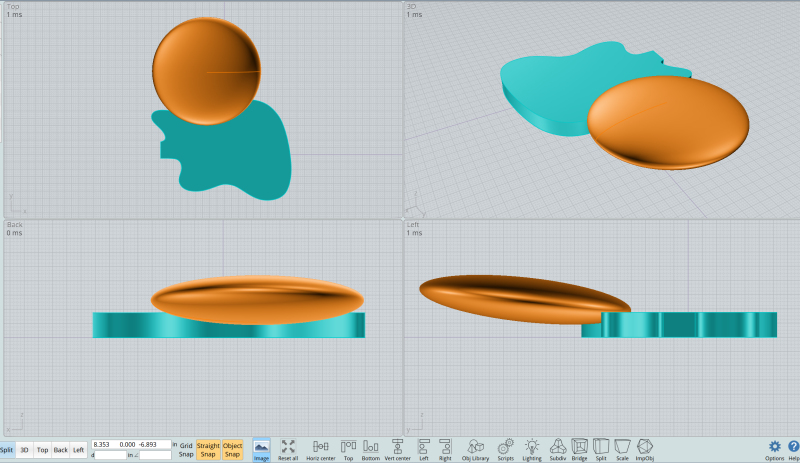
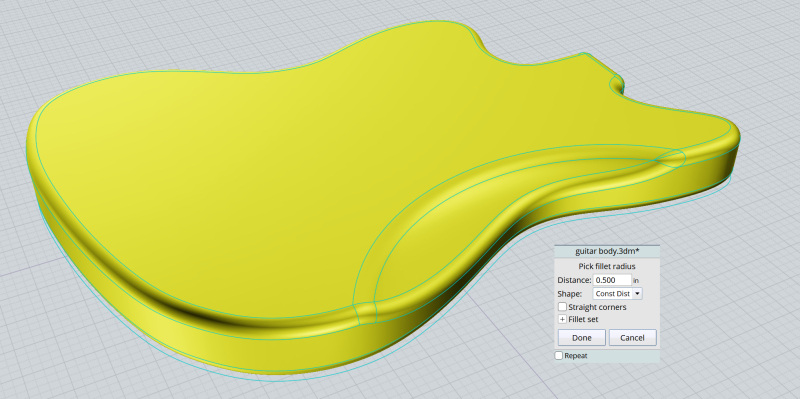
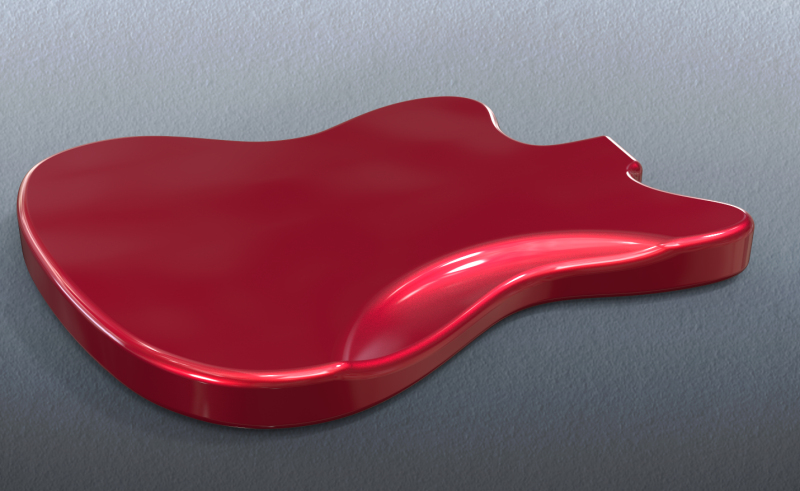
From: VG (VEGASGUITARS)
Thanks for the input Ed! Guessing that by changing the shape of the cutting solid that these types of contours can be achieved? Will give it a try. :)
From: ed (EDDYF)
Absolutely! Give this a try:
Draw a solid cone with a 7" radius and 1.5" height. Position it as shown. Be sure to use the alignment tool to position the base of the cone to the top surface of the guitar body.
Boolean Diff the cone from the guitar body.
Select only the single edge highlighted in yellow (2nd image). Fillet 0.2" Shape: Const Dist
Select the entire guitar body and Fillet 0.2" Shape: Const Dist
Ed Ferguson
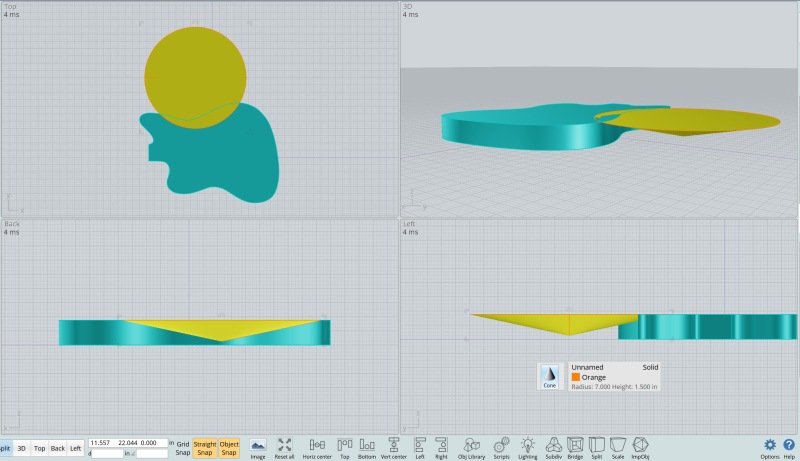
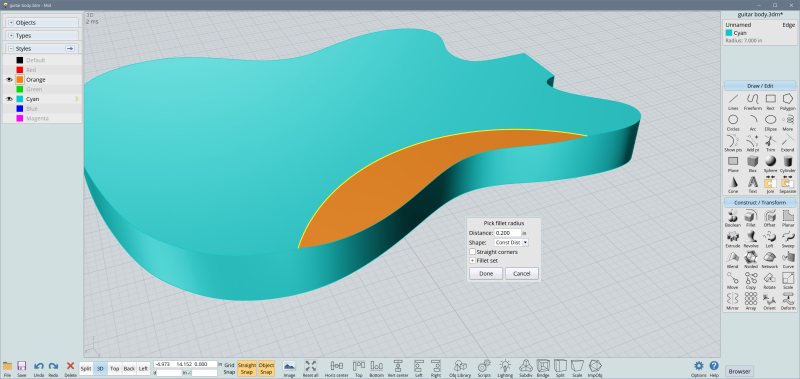
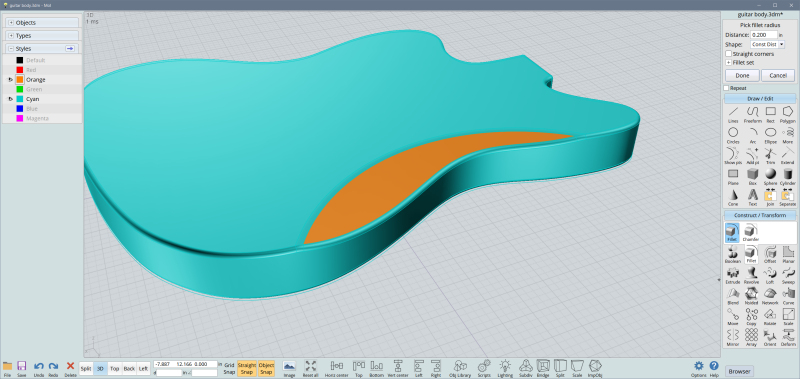
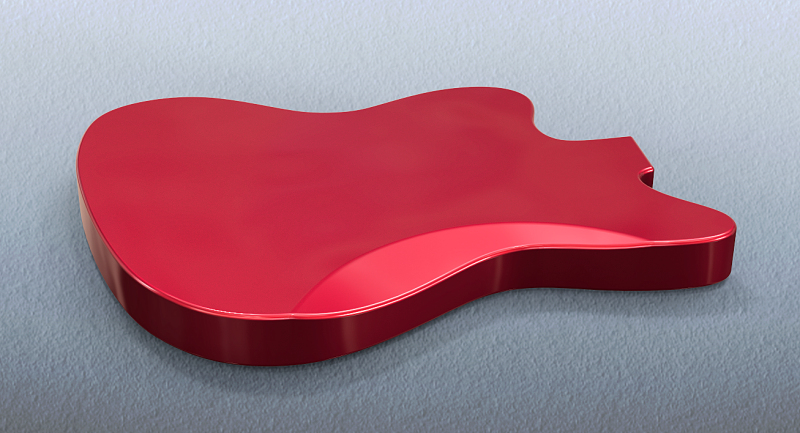
From: Finema
Well done Ed :)
"Select only the single edge highlighted in yellow (2nd image). Fillet 0.2" Shape: Const Dist
Select the entire guitar body and Fillet 0.2" Shape: Const Dist"
Why do it twice?
Thanks
From: ed (EDDYF)
.... Why do it twice?
I did not get good transitions where fillets branch doing it all at the same time.
Ed Ferguson
From: Finema
ok
Thanks :)
From: VG (VEGASGUITARS)
Wow that's awesome! Great work - thanks for sharing. :)
From: VG (VEGASGUITARS)
When I try it - I get a big hole in the side instead of a cut of a solid.
From: Michael Gibson
Hi Neil,
re:
> When I try it - I get a big hole in the side instead of a cut of a solid.
That will happen if you're doing a boolean on an object that isn't a solid. One solution is to make your object a solid first before attempting the boolean or another way is to use the Edit > Trim command to cut things up. The Trim command works on a surface level and you manually pick which areas to discard. Booleans automatically decide which pieces to discard based on what solid volume they are contained within but they aren't able to do that well when your objects are surfaces instead of solids.
So if you're working with surfaces usually Trim is preferred rather than booleans. Booleans on solids are kind of like a "batch mode" version of trim that automate some of the steps like discarding pieces and joining them.
- Michael
From: ed (EDDYF)
Verify the guitar body and the cone are both solids before performing Boolean Diff. To do so, select each object and look in the upper right of the main window. It should say "Solid".
Verify using cone is perfectly vertical and not tilted. Probably a good idea to construct a new solid cone and verify it snaps vertical.
Verify using the alignment tool that the base of the cone is on the same plane as the top of the guitar body.
Can you post the 3DM file?
BTW - Tried to send you a PM but the following error was encountered:
"VEGASGUITARS has opted out of receiving personal messages"
Ed Ferguson
From: VG (VEGASGUITARS)
Hi Ed - I've sent and received pms to other users without a problem - so don't know what's going on there.
Thanks for the pointers!
From: VG (VEGASGUITARS)
Yes my body says joined surfaces - so it is not solid. I'm guessing I will have to start over, then when the body is extruded and solid, do the cut then add the pockets and fillets?
From: ed (EDDYF)
... when the body is extruded and solid, do the cut then add the pockets and fillets?
Yes. Generally I start a model by making the largest, broadest alterations first, then work toward the smaller details. Much the same sequence you probably follow if making the body from wood by hand.
I also perform a copy/paste of my models within the same file at intermediate stages, so if something goes wrong I can easily go back and grab an earlier version.
Creating pockets should keep your guitar body a solid. If doing so breaks it into joined surfaces, you may want to analyze each step and see exactly what operation is breaking the solid.
Ed Ferguson
From: VG (VEGASGUITARS)
Excellent advice Ed! Many thanks.
From: ed (EDDYF)
I took a look at the other shape modification below. The only way I know how to make it without a seam or a noticeable transition, is to make a cutting surface (magenta colored curve) and slice a cut across the entire guitar body.
To do so, extrude the guitar body about a quarter inch taller than you need. So if the final guitar body is to be 1.75" thick, extrude it to 2".
Draw the magenta colored curve. I show it with the control points turned on. Note in the Left View that the top 3 control points are horizontally aligned. (Your alignment tools will also work to align control points if they are selected.
Extrude this curve across the entire guitar body.
Boolean Diff this surface with the guitar body and delete the top portion of the body. Note that the angle of the magenta color curve is important as you don't want to modify the shapes in other areas of the guitar.
Fillet at 0.2" Shape: Const Dist
Ed Ferguson
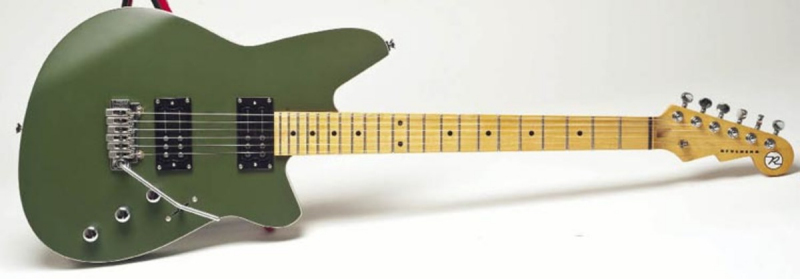
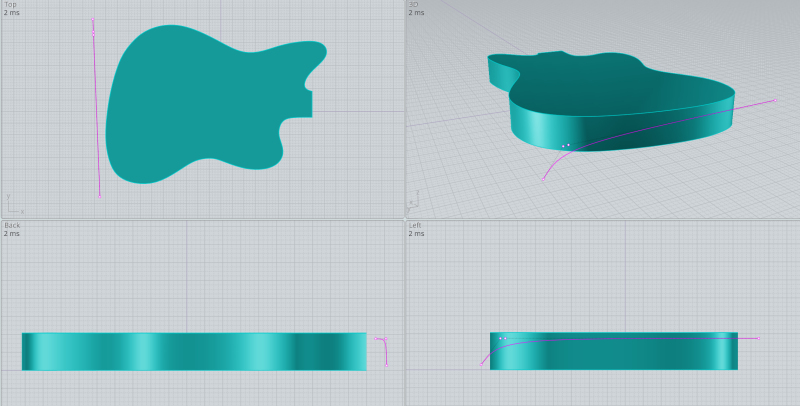
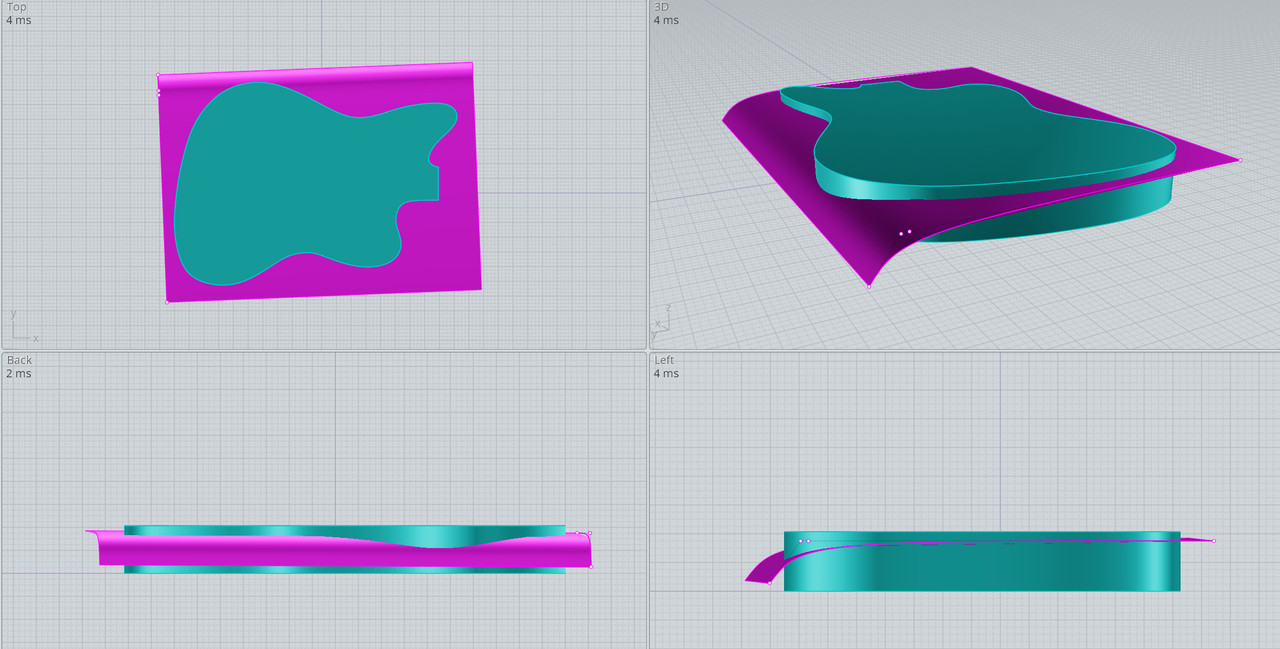
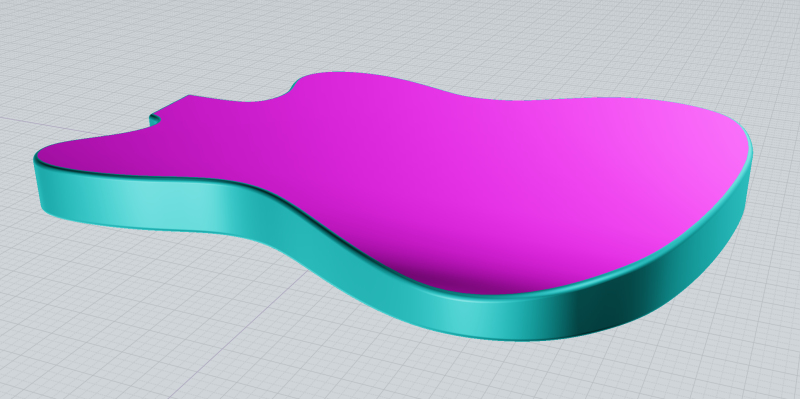
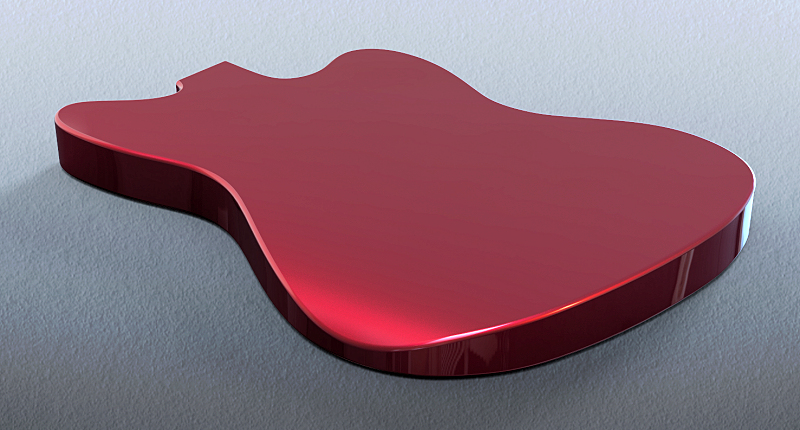
From: VG (VEGASGUITARS)
Thanks Ed - that's excellent work. Can't wait to try that.
Show messages:
1-20
21-40
41-60
61-80
81-99











